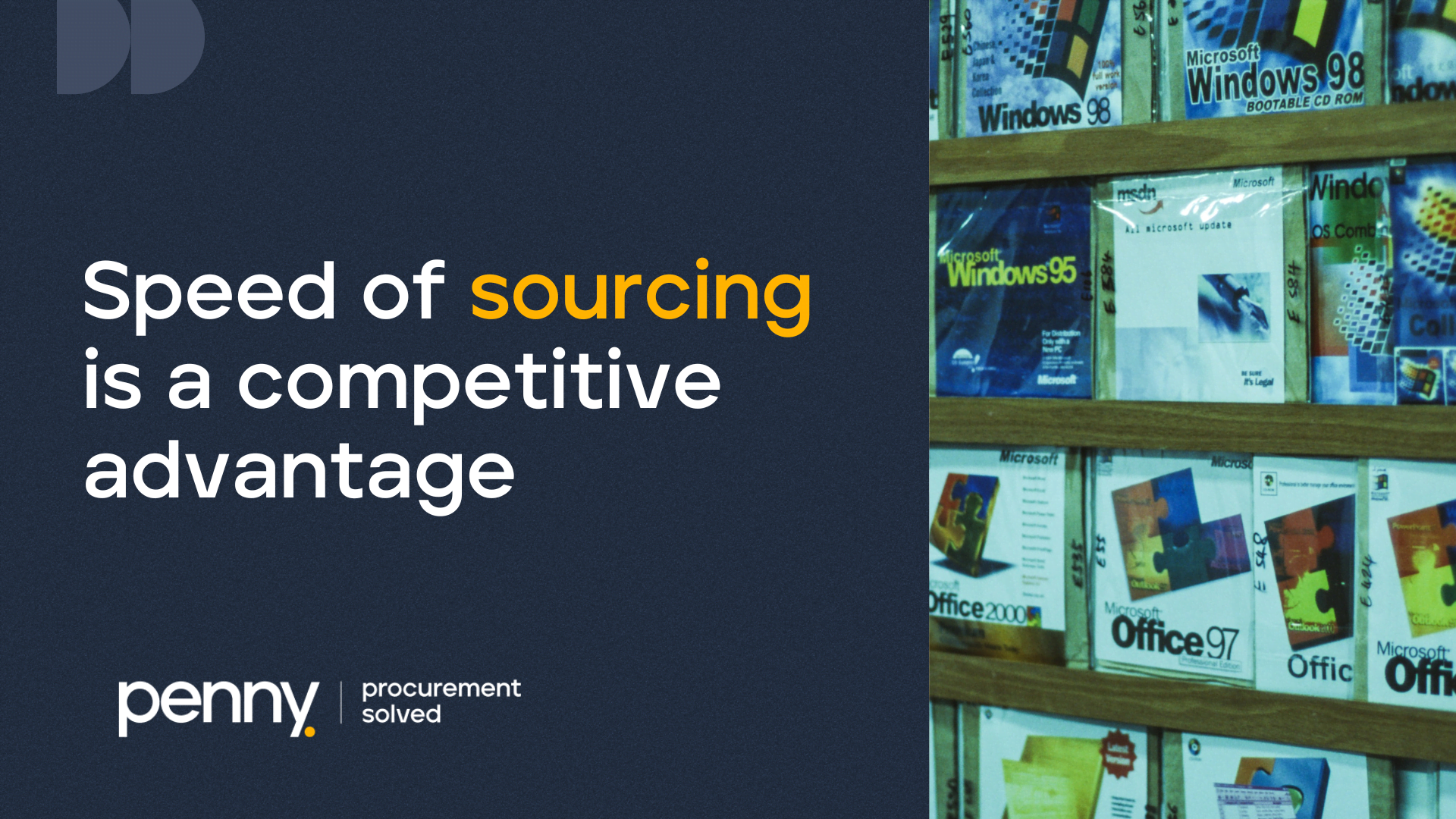
Procurement leaders often focus on cost savings, compliance, and supplier management. Yet one of the most overlooked levers of competitive advantage is speed. How fast your organisation can move from requisition to supplier award is not just an operational detail, it is a direct determinant of agility, cost position, and stakeholder satisfaction.
Organisations that accelerate sourcing cycles are more responsive to market changes, unlock trapped savings, and gain a reputational edge with suppliers. Those that drag sourcing events across weeks or months bleed value, frustrate stakeholders, and risk being left behind by faster-moving competitors.
Why speed matters in procurement
Agility in operations
Every sourcing delay has downstream effects. A late RFQ can delay a construction project by weeks, a missed supplier award can push a retail launch into the next season, and a stalled purchase order can idle manufacturing lines. In industries where margins are tight, operational agility is not a luxury, it’s survival.
Speed of sourcing means operations teams get what they need, when they need it. This keeps production schedules intact, ensures service delivery commitments are met, and strengthens procurement’s reputation as an enabler rather than a blocker.
Cost savings and negotiation power
Time is money, quite literally, in procurement!
Suppliers factor in risk and uncertainty when pricing bids. A slow, fragmented process leaves the buyer exposed to price fluctuations, competitor encroachment, or even supplier withdrawal. Conversely, decisive buyers who move quickly signal reliability and professionalism, often unlocking better terms, discounts, or preferential allocation.
Consider this: if your sourcing cycle is eight weeks and each week’s delay costs $15,000 in lost production or missed opportunities, the real cost of slowness compounds rapidly. Speed protects savings already negotiated and ensures opportunities aren’t eroded by indecision.
Internal stakeholder satisfaction
Procurement does not operate in isolation. Every sourcing decision impacts finance, operations, logistics, and even sales. When procurement lags, stakeholders perceive it as bureaucracy. When procurement delivers quickly, it becomes a trusted partner.
Fast sourcing builds credibility. Internal teams know they can rely on procurement to support strategic initiatives rather than slow them down. This perception shift elevates procurement’s role from transactional to strategic,positioning it as a driver of business outcomes.
Supplier relationships and trust
Suppliers prefer to work with organisations that act decisively. If you take weeks to respond, you risk losing the attention and goodwill of your best vendors. If you award quickly and communicate clearly, suppliers are more likely to prioritise your orders, extend favourable credit, or provide access to scarce capacity.
In today’s fragile supply chains, trust and responsiveness matter as much as price. Suppliers will choose to work with the customers who move with speed and clarity.
What causes slow sourcing
Manual workflows:
Endless email threads, Excel trackers, and disconnected approvals.
ERP-bound processes:
Procurement stuck inside rigid, complex ERP modules not designed for sourcing speed.
Data silos:
Supplier records scattered across departments, requiring re-validation every time.
Over-engineered approvals:
Too many handoffs, with no automation or prioritization.
Low adoption of tools:
Stakeholders bypass systems, forcing procurement back into firefighting mode.
These friction points do more than frustrate teams, they translate directly into lost savings, delays, and risk.
How organizations can accelerate sourcing
Digitize core workflows
Replace spreadsheets and emails with RFX automation. Templates, side-by-side bid comparisons, and digital award processes cut weeks into days.
Streamline approvals
Implement rules-based routing that automatically escalates urgent requests, reducing bottlenecks from days to hours.
Centralise supplier management
Onboard vendors once, maintain compliance records digitally, and reuse data across all sourcing events. This reduces duplication and improves compliance.
Integrate with ERP systems
Rather than competing with ERP, modern sourcing tools complement them, maintaining financial control while delivering usability and agility.
Measure sourcing velocity as a KPI
What gets measured gets managed. Leading organisations now track “average days from requisition to award” as a performance metric for procurement teams.
The business case for speed
Cutting sourcing cycle times by 30% is not just an operational win, it is a strategic lever that directly impacts financial performance, resilience, and relationships. When procurement accelerates, the organisation benefits across four dimensions:
Direct savings
Faster sourcing captures opportunities before they disappear.
Better pricing:
Suppliers often offer discounts or favourable terms to buyers who move quickly. Delays, on the other hand, allow prices to creep or competitors to undercut.
Avoidance of rush fees:
Prolonged sourcing cycles often result in last-minute purchases with expedited shipping, emergency labour costs, or unfavourable contract terms.
Example:
For a $20M sourcing budget, even a conservative 2% improvement in negotiated savings equates to $400k directly back to the bottom line
Revenue protection
Time lost in sourcing translates into revenue at risk.
Project delays:
Late sourcing of raw materials can idle production lines, with every day of downtime costing thousands.
Missed launches:
In retail or consumer goods, missing a seasonal launch window can cost millions in foregone sales.
Example:
A manufacturer with a $50k/day production value that loses five days to sourcing delays forfeits $250k in revenue, often dwarfing the savings from traditional cost-cutting.
Productivity and strategic focus
Slow sourcing consumes valuable procurement hours in administration and firefighting.
Manual tasks:
Chasing approvals, comparing spreadsheets, or validating supplier details steals time from high-value activities like category strategy or supplier innovation.
Reinvestment of time:
By automating sourcing workflows, teams can redirect capacity into supplier collaboration, sustainability projects, or new sourcing initiatives.
Example:
If a team of 5 buyers spends 20% of their time on avoidable admin, automation can free up the equivalent of one full-time headcount. worth $80k annually, without hiring.
Supplier goodwill and preferential treatment
Suppliers value speed as much as buyers do, as they want to conduct their business as fast as possible.
Preferred customer status:
Buyers who decide quickly often get first call on limited capacity or scarce materials.
Relationship capital:
Prompt communication signals professionalism, builds trust, and opens the door to collaborative deals.
Example:
In markets with constrained supply, suppliers allocate to reliable partners first. Being faster can mean access to stock while competitors wait.
The ROI in numbers
For a company with $10M in annual sourcing spend, digitizing approvals and automating supplier onboarding can realistically deliver:
- $250k in direct savings (capturing discounts, avoiding delays)
- Hundreds of thousands in revenue protection, depending on industry cycles
- $50–100k in productivity gains, by redeploying team capacity
- Hard-to-quantify supplier goodwill, which translates into preferential pricing and delivery
That adds up to a 5–7x ROI on modern procurement tools. In other words, speed doesn’t just pay for itself, it compounds value across the business.
The Penny perspective
At Penny, we see sourcing speed as the ultimate procurement advantage. By digitizing supplier onboarding, automating approvals, and creating ERP-compatible workflows, our clients consistently reduce cycle times by 30% or more.
The result is more than faster paperwork. It is operational agility, measurable savings, and stronger relationships. Procurement transforms from reactive gatekeeper into proactive business enabler.
Final thoughts
Speed of sourcing is not about cutting corners. It is about eliminating friction and enabling the business to move at the pace of opportunity.
Organizations that priorities sourcing agility will outperform competitors on cost, resilience, and stakeholder satisfaction. Those that don’t will continue to lose value with every delayed requisition, every missed supplier opportunity, and every frustrated stakeholder.
It’s time for procurement leaders to ask: How fast is our sourcing, and what is the cost of delay?
If you’re ready to reduce cycle times and turn speed into a competitive edge, download the Procurement Agility Playbook: How to Cut Sourcing Cycle Times by 30%.

